PSYCH101 - Theories of Personality
1/47
There's no tags or description
Looks like no tags are added yet.
Name | Mastery | Learn | Test | Matching | Spaced |
|---|
No study sessions yet.
48 Terms
Personality
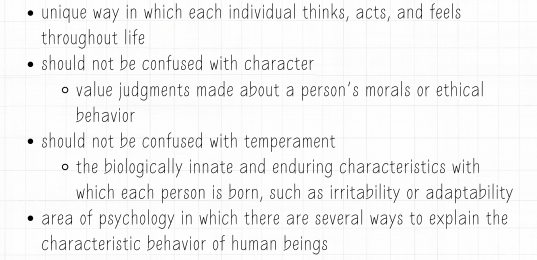
Freud
raised in Europe during the Victorian Age, a time of sexual repression sex should take place only in the context of marriage and then only to make babies to enjoy sexual intercourse was considered a sin
Mind Three Parts
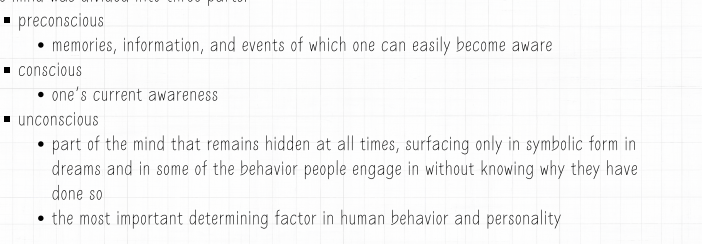
ID or it
most primitive part of the personality, present in the infant completely unconscious, pleasure-seeking, amoral part of the personality that exists at birth containing all of the basic biological drives: hunger, thirst, self-preservation, and sex Freud thought babies have sex drives by “ sex drive” he really meant “pleasure drive, ” the need to seek out pleasurable sensations
Ego or I
as infants begin to grow, adults start denying them their every wish part of the personality that develops out of a need to deal with reality mostly conscious, rational, and logical works on the reality principle
Superego or over the self
moral center of personality develops as a preschool-aged child learns the rules, customs, and expectations of society contains the conscience, the part of the personality that makes people feel guilt, or moral anxiety, when they do the wrong thin
Defense Mechanism
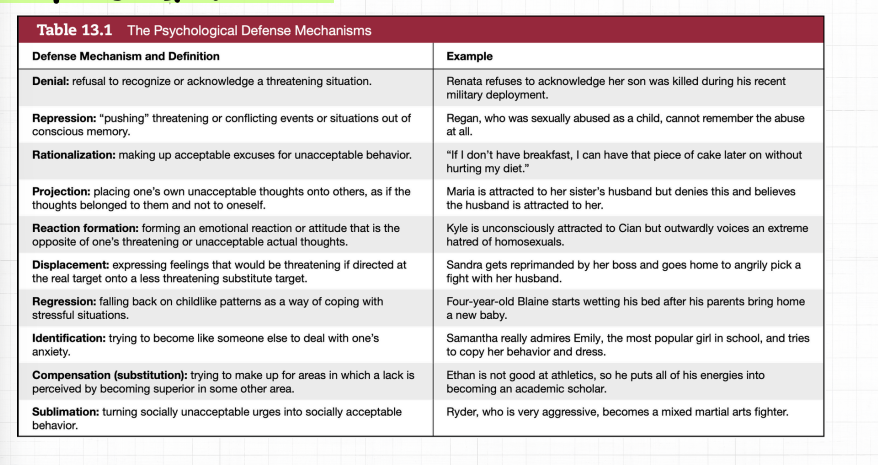
Psychosexual Stages of Personality
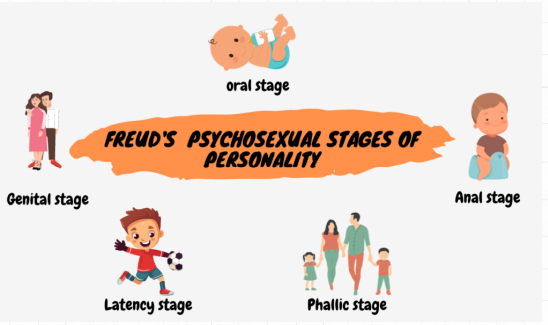
Oral Stage
erogenous zone: mouth conflict: weaning orally fixated adult personality: overeating, drinking too much, chain smoking, talking too much, nail biting, gum chewing, and a tendency to be either too dependent and optimistic (when the oral needs are overindulged) or too aggressive and pessimistic (when the oral needs are denied)
Anal Stage
erogenous zone: anus conflict: toilet training
anal expulsive personality someone who sees messiness as a statement of personal control somewhat destructive and hostile
anal retentive personality: terrified of making a mess rebel passively no mess, no punishment stingy, stubborn, and excessively neat
Phallic Stage
the sexual attraction is not that of an adult male for a female but more of a sexual curiosity that becomes mixed up with the boy’ s feelings of love and affection for his mother
his jealousy of his father leads to feelings of anxiety and fears that his father, a powerful authority figure, might get angry and do something terrible to deal with this anxiety, the boy will repress his sexual feelings for his mother and identify with his father (identification is one of the defense mechanisms used to combat anxiety)
the word phallic comes from the Greek word phallos and means “penis” castration anxiety: boys ’ fear of losing the penis penis envy: girls ’ feeling of envy because they were missing a penis erogenous zone: genitals conflict: awakening sexual feelings
Oedipus or Electra Complex
Oedipus was a king in a Greek tragedy who unknowingly killed his father and married his mother child develops a sexual attraction to the opposite-sex parent and jealousy of the same-sex parent males develop an Oedipus complex whereas females develop an Electra complex
latency stage
by the end of the phallic stage, children have pushed their sexual feelings for the opposite sex into the unconscious in another defensive reaction, repression children will remain in this stage of hidden, or latent, sexual feelings children grow and develop intellectually, physically, and socially but not sexually boys play only with boys, girls play only with girls, and each thinks the opposite sex is pretty awful
genital stage
sexual feelings that were once repressed can no longer be ignored sexual urges are once more allowed into consciousness, but these urges will no longer have the parents as their targets represented the final process in Freud’ s personality theory, as well as the entry into adult social and sexual behavior
Neo Freudian / Carl Gustav Jung
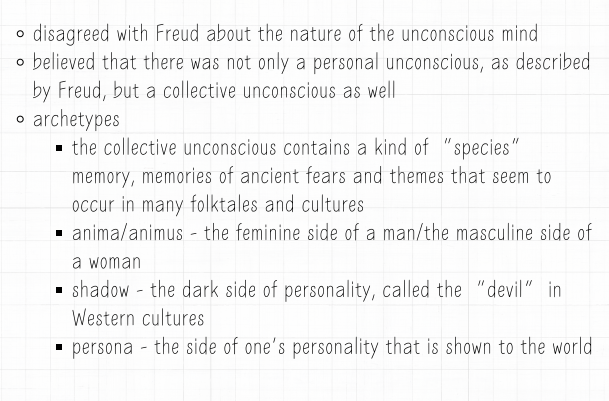
Alfred Adler

Karen Horney
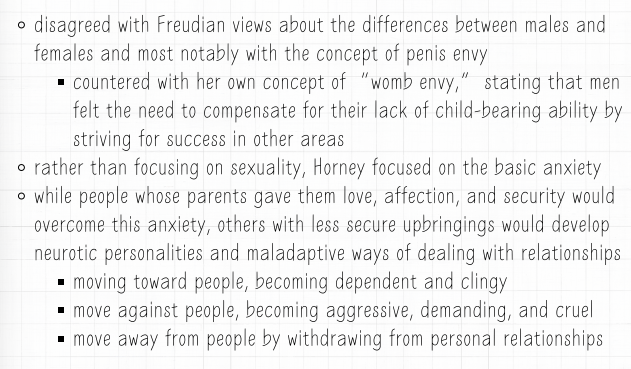
Erik Erikson
broke away from Freud’ s emphasis on sex, preferring instead to emphasize the social relationships that are important at every stage of life
Shy Personality
n childhood, a person might be exposed to a parent with a rather harsh discipline style (stimulus) avoiding the attention of that parent would result in fewer punishments and scoldings, so that avoidance response is negatively reinforced the “bad thing” or punishment is avoided by keeping out of sight and quiet child might generalize that avoidance response to other authority figures –- a pattern (habit) of shyness would develop
Reciprocal Determinism and self efficacy
three factors influence one another in determining the patterns of behavior that make up personality in a reciprocal, or give-and-take, relationship called reciprocal determinism environment behavior personal or cognitive factors that the person brings into the situation from earlier experiences
Bandura Model of Reciprucal Determinsim
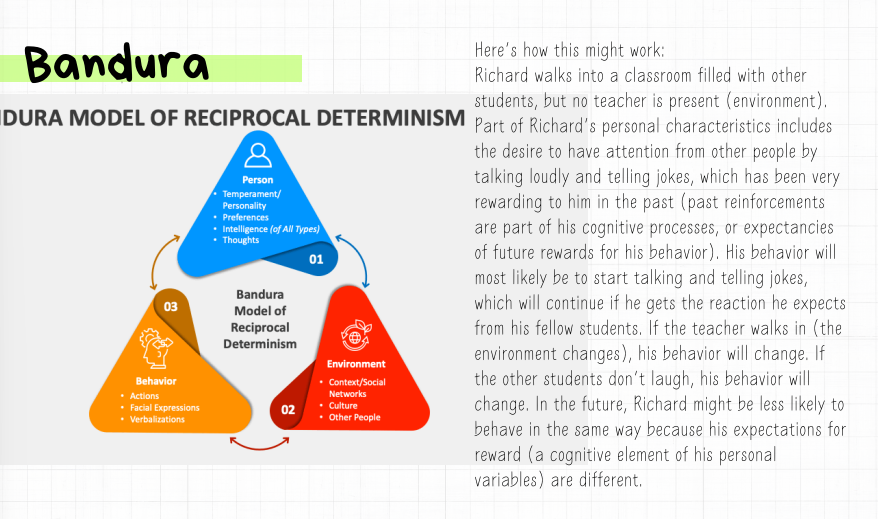
Self Efficacy
a person ’ s expectancy of how effective his or her efforts to accomplish a goal will be in any particular circumstance (not the same concept as self-esteem, which is the positive values a person places on his or her sense of worth) can be high or low, depending on what has happened in similar circumstances in the past (success or failure), what other people tell them about their competence, and their own assessment of their abilities people high in self-efficacy are more persistent and expect to succeed, whereas people low in self-efficacy expect to fail and tend to avoid challenges
Expectancies by Julian Rotter
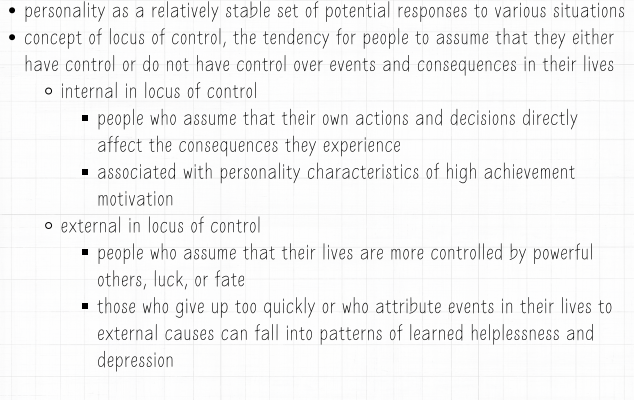
Expectancies 2 Key Factors
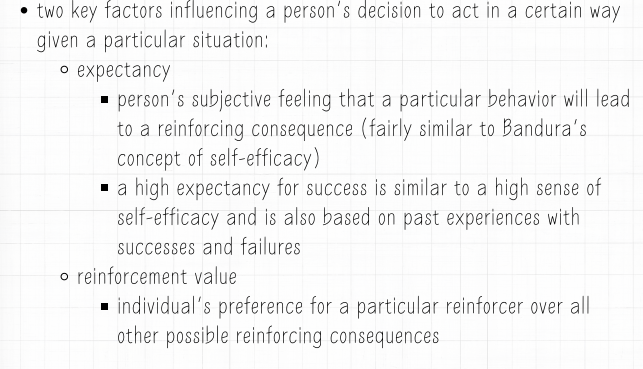
Humanism by Abraham Maslow and Carl Rogers
focus on the things that make people uniquely human, such as subjective emotions and the freedom to choose one’ s own destiny human beings are always striving to fulfill their innate capacities and capabilities and to become everything that their genetic potential will allow them to become
Self Actuazing Tendency
the striving to fulfill one’ s innate capacities and capabilities
Self Concept
the image of oneself that develops from interactions with important significant people in one’ s life
Real vs Ideal Self
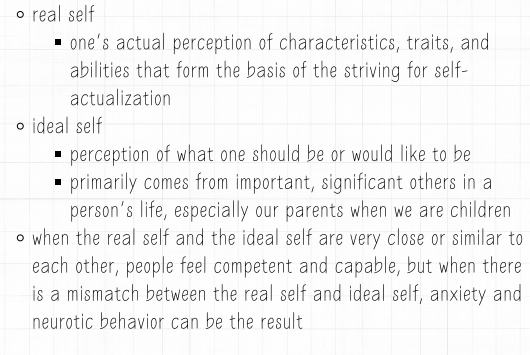
Positive vs Conditional P vs Unconditional P Regard
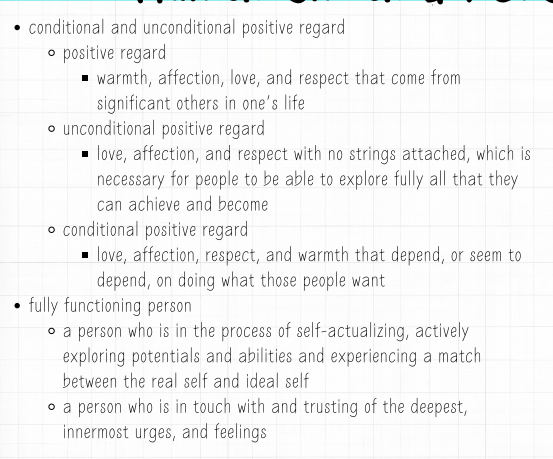
Trait Theories
less concerned with the explanation for personality development and changing personality than they are with describing personality and predicting behavior based on that description trait is a consistent, enduring way of thinking, feeling, or behaving describe personality in terms of a person ’ s tra
Gordon Allport
literally scanned the dictionary for words that could be traits, finding about 18,000, then paring that down to 200 traits after eliminating synonyms believed (with no scientific evidence, however) that these traits were literally wired into the nervous system to guide one’ s behavior across many different situations and that each person ’ s “constellation” of traits was unique (in spite of Allport’ s lack of evidence, behavioral geneticists have found support for the heritability of personality traits, and these findings are discussed in the next section of this chapter)
Raymond Cattell
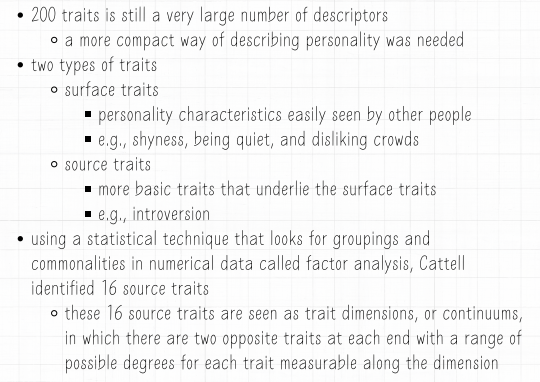
Five Factor Model / Big Five by Robert McRae abd Paul Costa
Robert McCrae and Paul Costa proposed that these five traits are not interdependent in other words, knowing someone’ s score on extraversion would not give any information about scores on the other four dimensions beyond descriptions of personality, there is a good deal of support for the predictive power of the five-factor model as well these traits predict many different outcomes in life, such as how we feel about ourselves, our physical and mental health, success in school and work, and various aspects of social behavior
Walter Mischel
personality traits will not always be expressed in the same way across different situations trait–situation interaction (Walter Mischel) the particular circumstances of any given situation are assumed to influence the way in which a trait is expressed an outgoing extravert, for example, might laugh, talk to strangers, and tell jokes at a party that same person, if at a funeral, would still talk and be open, but the jokes and laughter would be less likely to occur it appears these dimensions are evident or recognizable not only in most languages and cultures, they are also consistent when assessed by either self-ratings or observers
Direct Observation
psychologist observes the client engaging in ordinary, everyday behavior, preferably in the natural setting of home, school, or workplace, for example
Rating Scale
a numerical rating is assigned, either by the assessor or by the client, for specific behaviors
Frequency Count
the assessor literally counts the frequency of certain behaviors within a specified time limit
Personality Inventories
paper-and-pencil or computerized test that consists of statements that require a specific, standardized response from the person taking the test
Validity Scales
intended to indicate whether a person taking the inventory is responding honestly. indicate if people are trying to make themselves look better or worse than they are for example, and certain items are repeated throughout the test in a slightly different form, so that anyone trying to “fake” the test will have difficultly responding to those items consistently
MMPI-2-RF (Minnesota Multiphasic Personality Inventory, Version II, Restructured Form)
for abnormal behavior and thinking patterns in personality and psychopathology 338 statements such as “I am often very tense” or “I believe I am being plotted against”
self report data
clients can lie, distort the truth, misremember, or give what they think is a socially acceptable answer instead of true information interviewers themselves can be biased, interpreting what the client says in light of their own belief systems or prejudices remember Freud’ s theory?
halo/horn effect
tendency to form a favorable or unfavorable impression of someone at the first meeting, so that all of a person ’ s comments and behavior after that first impression will be interpreted to agree with the impression—positively or negatively sometimes the negative impression is called the “horn effect”
observer effect + bias
a person observing a client for a particular behavior may not see that behavior occur within the observation time—much as some car problems never seem to show up when the mechanic is examining the car
projective tests
personality assessments that present ambiguous visual stimuli to the client and ask the client to respond with whatever comes to mind the hope is that the client will project unconscious concerns onto the visual stimulus, revealing them to the examiner performance based and can be used to explore a client’ s personality or used as a diagnostic tool to uncover problems in personality
Rorschach Inkblot Test
10 inkblots, 5 in black ink on a white background and 5 in colored inks on a white background using predetermined categories and responses commonly given by people to each picture (Exner, 1980), psychologists score responses on key factors, such as reference to color, shape, figures seen in the blot, and response to the whole or to details used to describe personality, diagnose mental disorders, and predict behavior however, along with the use of other projective techniques in general, their use is controversial given questions about some scoring methods and overall validity
Thematic Apperception Test
20 pictures, all black and white, that are shown to a client the client is asked to tell a story about the person or people in the picture, who are all deliberately drawn in ambiguous situations the story developed by the client is interpreted by the psychoanalyst, who looks for revealing statements and projection of the client’ s own problems onto the people in the pictures